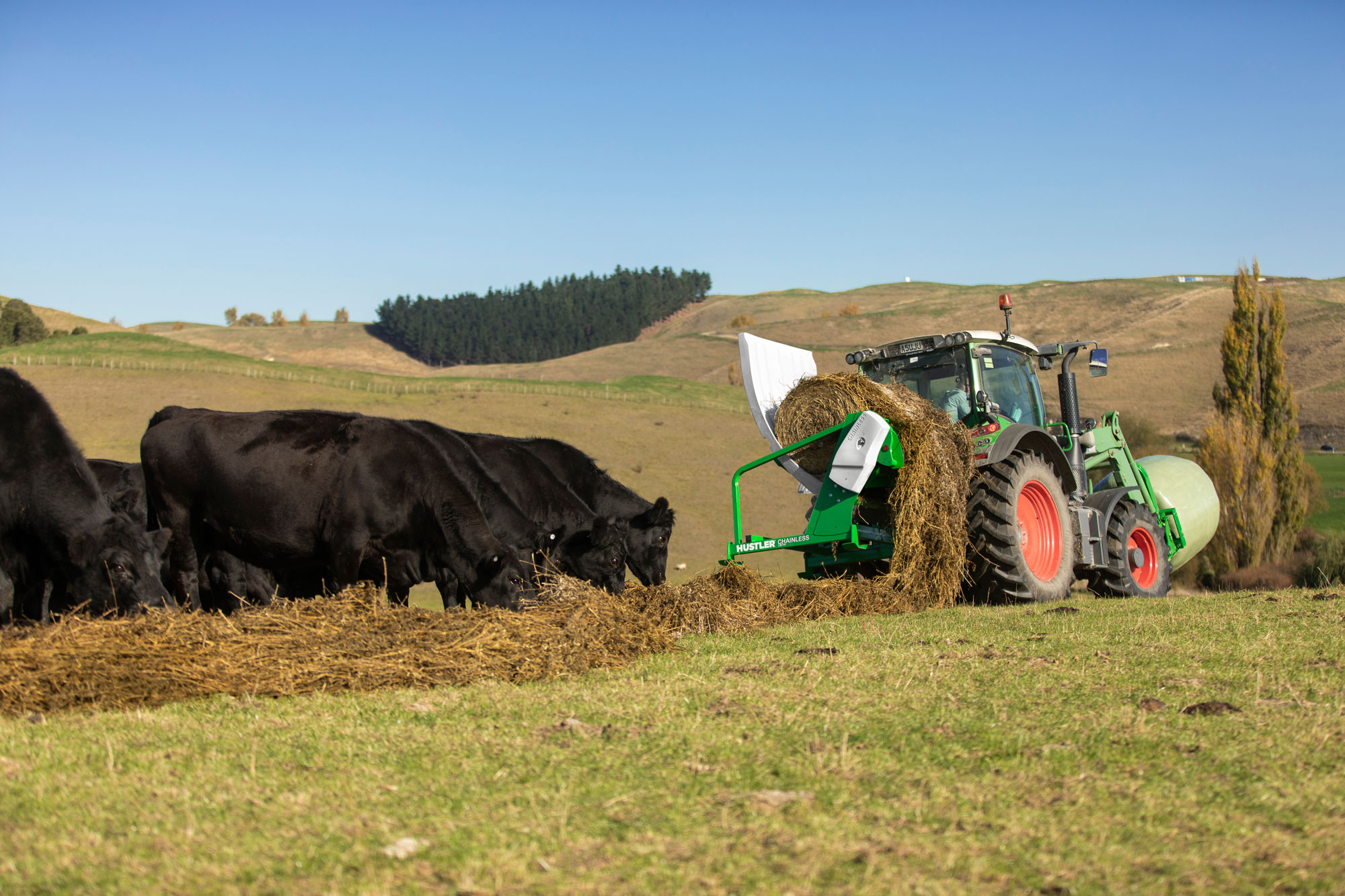The Art of Sustainable Hay Feeding in a Tough Economy
Livestock feed represents the largest single cost – often up to 60 percent of the total operation spending. Maybe now is the time to rethink your feeding methods.

The average bred cow weighs about 1,200 pounds and typically consumes 2.5% of her body weight on short stem hay, or 30 pounds/day of hay. Over an 80-cow herd, that is 2,400 pounds of forage-fed daily or over 180 tons during a 5-month timeframe. At $55/ ton1, you will spend about $9,900 over that period.
According to a study by Dr. David Lalman of Oklahoma State University, “… the cows eating long stem consumed 1.8% of their body weight in dry matter (DM) intake and retained the same body condition.”2 So imagine if you could feed out long-stem hay reliably with a bale processor, how much could you save?
Three essential factors can make a massive difference on your bottom line: hay wastage, forage quality, and the impact of your feeding method on pastures.
Drastically reduce your hay wastage
Wondering how many pounds of hay your cows are eating each day is maybe the wrong question. You should be asking how much hay your cows are wasting every day. Hay wastage depends on harvesting and storage techniques, but more importantly on the way it’s fed out.
Consider that more than 40% of your hay could be wasted3 because of losses associated with your feeding method. That’s like buying 100 bales of hay and then sticking a match to 40 of them! If we use the example we presented in the introduction, it means that in the best-case scenario, you are going to waste around 72 tons of forage this winter.
Maybe now is the time to think ahead and re-evaluate the efficiencies of your bale feeding system. One popular method is unrolling the bale on the ground in a thick matt. Another method, bale processing, is to chop the forage and feed out in large, thick windrows, resulting in huge losses because the hay is quickly blown away or trampled because too much hay is fed in one location. Alternatively, the Chainless bale processors, such as the mounted Chainless LX105™ bale processor or the trailed Chainless TX205™ bale processor from Hustler Equipment are designed to maximize every pound of DM thanks to their unique, gentle teasing action, pulling the hay apart in long stems, making the feed more palatable for stock and allowing you to feed out the exact amount in a long, thin windrow, drastically reducing nutritional loss and hay waste.
Preserve the goodness of your hay
You already know that everything starts with the quality of your feed. Most operations put a lot of time, money, and effort into harvesting and storing the highest quality hay possible. Doesn’t it seem like you should carefully consider how you feed it out?
Most of the nutrition is retained in the leaves and/or grain; why create a bunch of dust and pulverize your hay by feeding with a traditional flailtype bale processor? To maximize nutritional uptake, it is essential to gently fluff the hay out, so it’s not broken up and the nutrients destroyed and lost. The patented rotor system of the Hustler Chainless bale processors can help to achieve that result very easily in a limited amount of time.
Though minimizing wasted forage and being cost-effective is a key concern, it is far from the only worry. For most livestock ranchers, the main reason for allowing unlimited access to hay is the time and convenience. A study4 conducted by Dennis Hancock from the University of Georgia compared the time expended feeding dry hay to six groups of heifers. The result of this study shows that using a Chainless bale processor is by far the quickest way to feed out hay; even faster than a traditional hay unroller, a hay wagon, or even a hay ring.
Manage your pasture with your feeding routine
The benefits of using a bale processor are not all about hay savings. Robert Kallenbach from the University of Missouri5 found that for in 1.9 tons of high-quality hay, your cows will return $86 in nutrients to the soil in the form of fertilizer. Based on the same figures we presented in the introduction, it means that you could recycle up to $8,150 worth of fertilizer (manure) through cows fed on grass hay.
Old permanent pasture can be up to 25% less responsive and absorptive of nutrients in the soil, such as nitrogen, than newly renovated pastures. Regular reseeding would increase pasture productivity, but it’s a huge time and money investment. Ideally, feeding in a new part of the pasture every day in a long narrow windrow gives every animal equal access to feed and the hay bales drop their seeds into the ground in the process. Your whole pasture can be reseeded for (virtually) free and with no additional time spent while at the same time reducing compaction by keeping the animals spread out.
If you want to increase your pasture production and herd health along with reducing your hay wastage, you should rethink your feeding method immediately.
Lance Paskewitz, Hustler Business Development – North America


























